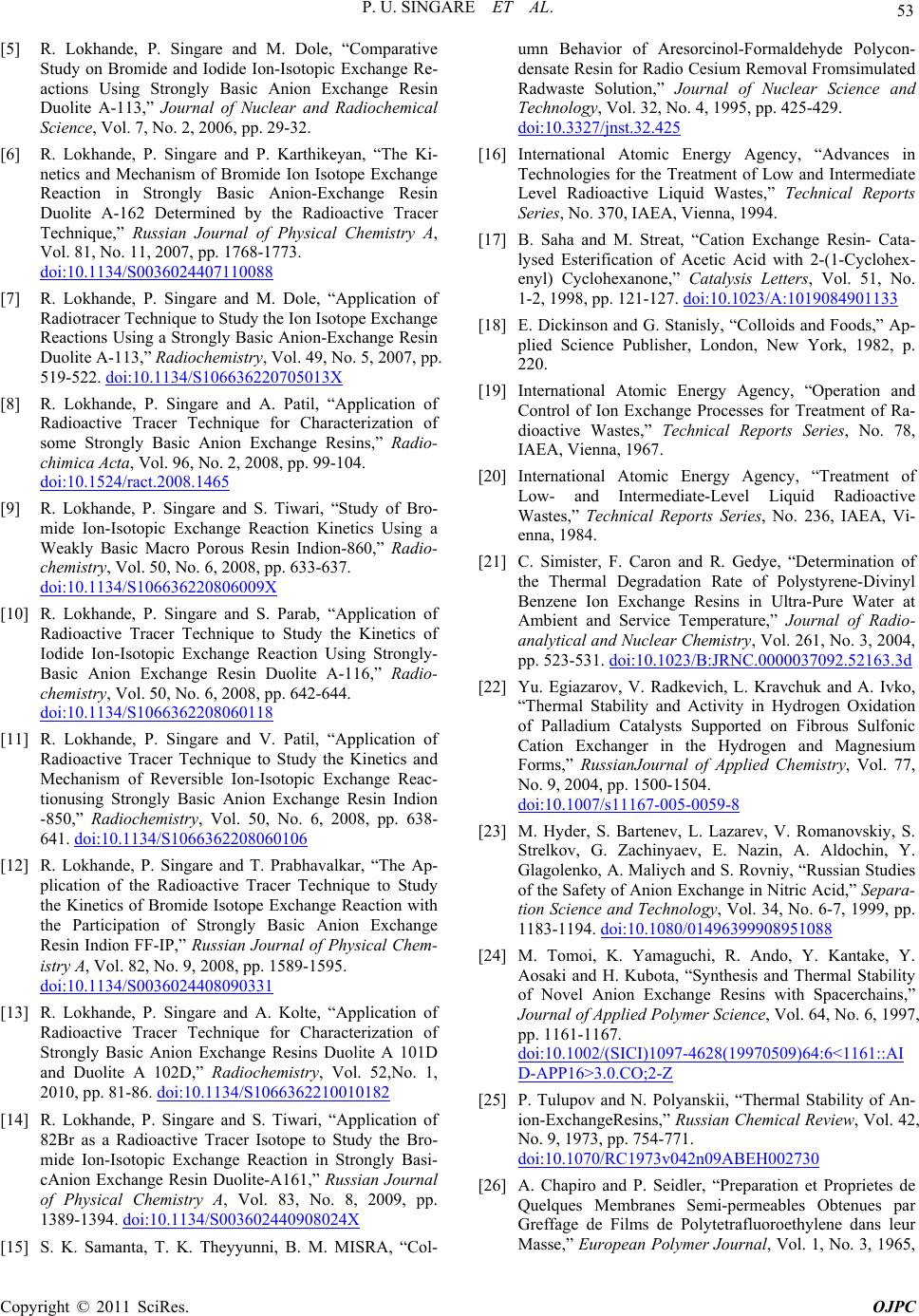
P. U. SINGARE ET AL.
53
[5] R. Lokhande, P. Singare and M. Dole, “Comparative
Study on Bromide and Iodide Ion-Isotopic Exchange Re-
actions Using Strongly Basic Anion Exchange Resin
Duolite A-113,” Journal of Nuclear and Radiochemical
Science, Vol. 7, No. 2, 2006, pp. 29-32.
[6] R. Lokhande, P. Singare and P. Karthikeyan, “The Ki-
netics and Mechanism of Bromide Ion Isotope Exchange
Reaction in Strongly Basic Anion-Exchange Resin
Duolite A-162 Determined by the Radioactive Tracer
Technique,” Russian Journal of Physical Chemistry A,
Vol. 81, No. 11, 2007, pp. 1768-1773.
doi:10.1134/S0036024407110088
[7] R. Lokhande, P. Singare and M. Dole, “Application of
Radiotracer Technique to Study the Ion Isotope Exchange
Reactions Using a Strongly Basic Anion-Exchange Resin
Duolite A-113,” Radiochemistry, Vol. 49, No. 5, 2007, pp.
519-522. doi:10.1134/S106636220705013X
[8] R. Lokhande, P. Singare and A. Patil, “Application of
Radioactive Tracer Technique for Characterization of
some Strongly Basic Anion Exchange Resins,” Radio-
chimica Acta, Vol. 96, No. 2, 2008, pp. 99-104.
doi:10.1524/ract.2008.1465
[9] R. Lokhande, P. Singare and S. Tiwari, “Study of Bro-
mide Ion-Isotopic Exchange Reaction Kinetics Using a
Weakly Basic Macro Porous Resin Indion-860,” Radio-
chemistry, Vol. 50, No. 6, 2008, pp. 633-637.
doi:10.1134/S106636220806009X
[10] R. Lokhande, P. Singare and S. Parab, “Application of
Radioactive Tracer Technique to Study the Kinetics of
Iodide Ion-Isotopic Exchange Reaction Using Strongly-
Basic Anion Exchange Resin Duolite A-116,” Radio-
chemistry, Vol. 50, No. 6, 2008, pp. 642-644.
doi:10.1134/S1066362208060118
[11] R. Lokhande, P. Singare and V. Patil, “Application of
Radioactive Tracer Technique to Study the Kinetics and
Mechanism of Reversible Ion-Isotopic Exchange Reac-
tionusing Strongly Basic Anion Exchange Resin Indion
-850,” Radiochemistry, Vol. 50, No. 6, 2008, pp. 638-
641. doi:10.1134/S1066362208060106
[12] R. Lokhande, P. Singare and T. Prabhavalkar, “The Ap-
plication of the Radioactive Tracer Technique to Study
the Kinetics of Bromide Isotope Exchange Reaction with
the Participation of Strongly Basic Anion Exchange
Resin Indion FF-IP,” Russian Journal of Physical Chem-
istry A, Vol. 82, No. 9, 2008, pp. 1589-1595.
doi:10.1134/S0036024408090331
[13] R. Lokhande, P. Singare and A. Kolte, “Application of
Radioactive Tracer Technique for Characterization of
Strongly Basic Anion Exchange Resins Duolite A 101D
and Duolite A 102D,” Radiochemistry, Vol. 52,No. 1,
2010, pp. 81-86. doi:10.1134/S1066362210010182
[14] R. Lokhande, P. Singare and S. Tiwari, “Application of
82Br as a Radioactive Tracer Isotope to Study the Bro-
mide Ion-Isotopic Exchange Reaction in Strongly Basi-
cAnion Exchange Resin Duolite-A161,” Russian Journal
of Physical Chemistry A, Vol. 83, No. 8, 2009, pp.
1389-1394. doi:10.1134/S003602440908024X
[15] S. K. Samanta, T. K. Theyyunni, B. M. MISRA, “Col-
umn Behavior of Aresorcinol-Formaldehyde Polycon-
densate Resin for Radio Cesium Removal Fromsimulated
Radwaste Solution,” Journal of Nuclear Science and
Technology, Vol. 32, No. 4, 1995, pp. 425-429.
doi:10.3327/jnst.32.425
[16] International Atomic Energy Agency, “Advances in
Technologies for the Treatment of Low and Intermediate
Level Radioactive Liquid Wastes,” Technical Reports
Series, No. 370, IAEA, Vienna, 1994.
[17] B. Saha and M. Streat, “Cation Exchange Resin- Cata-
lysed Esterification of Acetic Acid with 2-(1-Cyclohex-
enyl) Cyclohexanone,” Catalysis Letters, Vol. 51, No.
1-2, 1998, pp. 121-127. doi:10.1023/A:1019084901133
[18] E. Dickinson and G. Stanisly, “Colloids and Foods,” Ap-
plied Science Publisher, London, New York, 1982, p.
220.
[19] International Atomic Energy Agency, “Operation and
Control of Ion Exchange Processes for Treatment of Ra-
dioactive Wastes,” Technical Reports Series, No. 78,
IAEA, Vienna, 1967.
[20] International Atomic Energy Agency, “Treatment of
Low- and Intermediate-Level Liquid Radioactive
Wastes,” Technical Reports Series, No. 236, IAEA, Vi-
enna, 1984.
[21] C. Simister, F. Caron and R. Gedye, “Determination of
the Thermal Degradation Rate of Polystyrene-Divinyl
Benzene Ion Exchange Resins in Ultra-Pure Water at
Ambient and Service Temperature,” Journal of Radio-
analytical and Nuclear Chemistry, Vol. 261, No. 3, 2004,
pp. 523-531. doi:10.1023/B:JRNC.0000037092.52163.3d
[22] Yu. Egiazarov, V. Radkevich, L. Kravchuk and A. Ivko,
“Thermal Stability and Activity in Hydrogen Oxidation
of Palladium Catalysts Supported on Fibrous Sulfonic
Cation Exchanger in the Hydrogen and Magnesium
Forms,” RussianJournal of Applied Chemistry, Vol. 77,
No. 9, 2004, pp. 1500-1504.
doi:10.1007/s11167-005-0059-8
[23] M. Hyder, S. Bartenev, L. Lazarev, V. Romanovskiy, S.
Strelkov, G. Zachinyaev, E. Nazin, A. Aldochin, Y.
Glagolenko, A. Maliych and S. Rovniy, “Russian Studies
of the Safety of Anion Exchange in Nitric Acid,” Separa-
tion Science and Technology, Vol. 34, No. 6-7, 1999, pp.
1183-1194. doi:10.1080/01496399908951088
[24] M. Tomoi, K. Yamaguchi, R. Ando, Y. Kantake, Y.
Aosaki and H. Kubota, “Synthesis and Thermal Stability
of Novel Anion Exchange Resins with Spacerchains,”
Journal of Applied Polymer Science, Vol. 64, No. 6, 1997,
pp. 1161-1167.
doi:10.1002/(SICI)1097-4628(19970509)64:6<1161::AI
D-APP16>3.0.CO;2-Z
[25] P. Tulupov and N. Polyanskii, “Thermal Stability of An-
ion-ExchangeResins,” Russian Chemical Review, Vol. 42,
No. 9, 1973, pp. 754-771.
doi:10.1070/RC1973v042n09ABEH002730
[26] A. Chapiro and P. Seidler, “Preparation et Proprietes de
Quelques Membranes Semi-permeables Obtenues par
Greffage de Films de Polytetrafluoroethylene dans leur
Masse,” European Polymer Journal, Vol. 1, No. 3, 1965,
Copyright © 2011 SciRes. OJPC